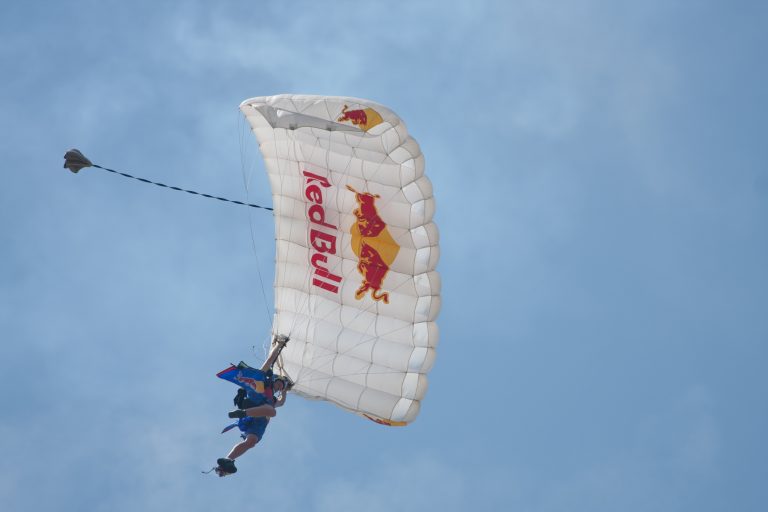Energy drink giant Red Bull finished 2016 as the most shared brand in all the land. Last year, Red Bull sports and music videos generated more than 27 million shares via Facebook, YouTube and other online sites. The brand garnered more than twice as many shares as the one in second place (Samsung, 12.5 million), and three times as many views as the third place (McDonald’s, 8.6 million). It plain beat the brakes off of Nike and Adidas.
For a company that makes only one product, it’s a pretty astonishing feat of branding. I’d imagine far more people wear Nikes and eat McDonald’s than drink Red Bull. But a guy I knew in high school got a Red Bull tattoo on his arm as soon as he turned 18. Sure, he drank the energy drink, but Red Bull, as a brand, is barely about an energy drink.
In 2012, Red Bull sponsored and live-streamed Austrian skydiver Felix Baumgartner’s Stratos mission, a 24-mile free fall in which he reached a velocity of 843 mph, breaking the sound barrier, before landing literally on his feet on the ground in New Mexico. To see Baumgartner clad in a heavily-logoed space suit, poised to jump from the ledge of his pod-like mechanism so far above the earth that its atmosphere seems nothing more than a neon wisp under the crushing blackness of space, is a powerful image.
The feat remains the most live-streamed event in history.
While Nike also has a great online video presence, it’s very clear Nike is only interested in celebrating performance at a high level if that performance is being achieved by someone while he or she is using a Nike product. By contrast, Red Bull doesn’t ask its cliff divers to chug a Red Bull on the way down.
This is an exaggerated example of what Red Bull does right as a brand. It markets itself not only as an energy drink, but as a sponsor of extremity. The narrative isn’t that a can of Red Bull just gets you through the day, but that it “gives you wings.” It allows you to do the impossible.
The brand seeks out people who push the limits, whether of their own accord or through such Red Bull-sponsored venues as its Flugtag events. Red Bull doesn’t push the energy drink itself as much as it offers its brand as a platform for people to tell their stories. It looks to lift up the metaphorical rock to expose and enable the rich, hidden life teeming underneath.
Red Bull’s latest endeavor, Red Bull TV, aims to create a lot more than simple shareability. The website/app offers a nice range of episodic pieces following extreme sports athletes and teams, along with documentaries on music and culture. One Red Bull TV documentary, “Snowman,” follows an avalanche forecaster who drops bombs from helicopters to settle unstable snow and minimize risk for those living, working and playing on the mountain. Moreover, Red Bull sponsors competitors in fields that don’t immediately come to mind when we think about action — including golfers, ski jumpers, chess players, and Super Smash Bros. Melee champions. The shows aren’t elaborate commercials for the energy drink. Together, they drive a larger conversation about the value of risk and the myriad ways in which people seize the day.
And that’s always interesting. In our celebrity-obsessed society, it’s refreshing to come across people doing what they’re doing, chasing whatever rush they’re chasing, for motives other than fame. A recent Red Bull spot proclaims, “There’s always someone seeking out adventure, attempting the impossible and going all out.”

In other words, these thrill-seekers would be doing what they do even if no one were watching. That’s called “passion.” Red Bull’s brand strategy is to remind us all how it feels (or felt!) to be young — to “kick it” with your friends when you’re too young to care about safety more than fun, and to feel the thrill that comes from rising to meet a higher, more extreme call to action.
So yes, when you buy Red Bull, you are getting an energy drink. But you’re also buying into passion — into folks innovating what the human is capable of, often at the extreme risk of their own well-being.
When you buy Red Bull, you’re saying, “Right on!” to the skydiving-from-space, vertical-cliff-slope-skiing, death-defying-bike-flipping thrill seekers out there.
The question for the rest of us is this: In our work, what are we seeking to capital-D Do for people? Does your product or service strive to offer entry into a larger conversation? Do you care about the passions and endeavors of your customers, and are you making it more possible for them to live out their passions?
If you can’t answer, “Yes!” to all of these questions, rest assured that someone else can — and that they’ll take your business every time, because they make their customers feel valued.




